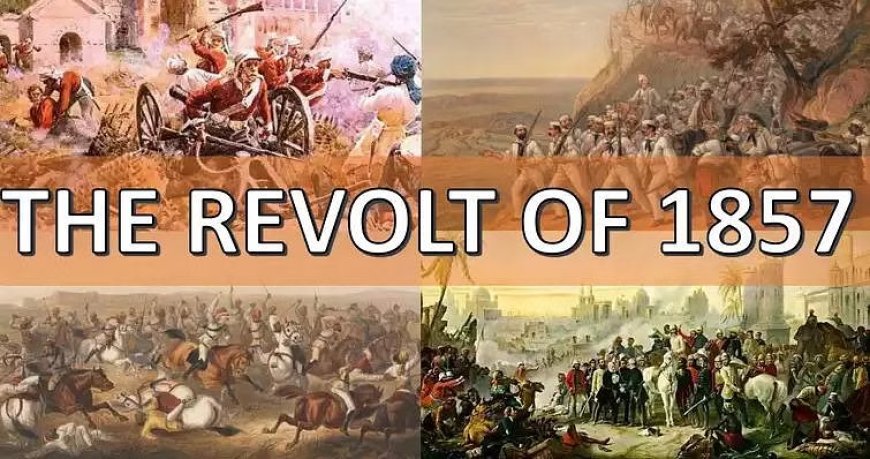The Revolt of 1857 - First Step Towards Independence
The revolt of 1857 is one of the most crucial parts of Indian freedom history it has many names like Sepoy mutiny, military outrage, feudal uprising, etc. so here is a brief description of the revolt by examrewards.com

The revolt of 1857 is one of the most crucial part of Indian freedom history it has many names like Sepoy mutiny, military outrage, feudal uprising, etc. so here is a brief description of the revolt by examrewards.com
CONTENT
· INTRODUCTION
· IMMEDIATE REASONS
· CAUSES
· MAJOR EVENTS OF REVOLT
· WHY REVOLT FAILED
· IMPORTANT DATES
· VIEWS
INTRODUCTION
The revolt of 1857 which was a product of the character and policies of colonial rule and major problems faced after 1757, simmering discontent burst in the form of a violent storm in 1857 shook the British Empire in India to its foundation, as we know the period between 1757 to 1857 was not peaceful. there were a series of events that created severe discontent like British interference in native religious/traditional customs, etc...
IMMEDIATE REASONS - SPARK
Reports like the mixing of bone dust in Atta and the introduction of the Enfield rifle created sudden outrage in Sepoys. greased wrapping paper of the cartridge of the new rifle had to be bitten off before loading and grease was made of beef and pig fat.
The cow was sacred to Hindus and a pig was taboo for Muslims which created a grave danger of losing their religion among Sepoys. Man of them believes that the government is trying to destroy their religion and convert them to Christianity. these were some of the cheap acts done by the Britishers.
Causes
· Economic causes: complete exploitation of the economy and heavy taxation leads to poverty. peasants resorted to loans from money lenders at exorbitant rates, later forcefully evicting farmers from their land on nonpayment of debts.
Britishers also impose high tariffs on Indian-made goods which lead to the end of Indian-made goods Britishers simply killed many Indian manufacturers.
· Political causes: Britishers impose various greedy policies like - The doctrine of lapse, subsidiary alliance, right of succession denied to Hindu princes, and various other acts with the intention of expansion and acquiring other territories.
· Administrative causes: Rampant corruption at lower level leads to major exploitation of common people by police and petty officials and lower courts was a major cause of severe discontent.
· Social religious causes: socio-religious reforms like abolition of sati, support to widow remarriage, and woman's education, these types of interference by outsiders were not acceptable to Indians.
Racial overtone and superiority complex were the major part of the attitude of British administration and there were various acts like the Religious Disability Act of 1856, the tax on mosques and temples created outrage and hurt the sentiments of Indians.
· Discontent among Sepoys
Finally Sepoys from where the revolt begins there were various reasons like -
Restriction on wearing sectarian marks
In 1856, the lord canning government passed the general service enlistment act, according to which future recruits of the Bengal Army needed to serve anywhere.
Sepoys would not be given foreign-service allowance [Bhatta] when serving in Sindh or Punjab.
Annexation of Awadh which was home of many Sepoys.
Major events of the revolt
Start at Meerut: the revolt began at Meerut, 58km from Delhi on May 10, 1857, and then spread in Punjab in the north and Narmada in the south Bihar in the east, and Rajputana in the west.
Bahadur Shah as symbolic head: aged and powerless Bahadur Shah was proclaimed as emperor of India, Delhi became the center of the great revolt and Bahadur Shah its symbol.
Other storm centers and their leaders were -
· Kanpur – Nana saheb (adopted son of last Peshwa ruler baji rao 2)
· Lucknow- Begum Hazrat Mahal
· Bareilly - Khan Bahadur
· Bihar - Kunwar Singh
· Jhansi - Maharani laxmi bai ( joined by Tantia tope)
· Faizabad - Maulvi Ahmadullah
Civilians join the revolt of Sepoys accompanied by the civil population, particularly from the north-west province and Awadh, with widespread participation from the peasantry, laborers, artists, zamindars, Priests, etc.
Why revolt failed
· All classes didn’t join: certain classes didn’t take part and work against the revolt.
· Poor arms and Equipment: where Britishers were equipped with the latest guns and other weapons, Indians were using swords and spears which gives Britishers the upper hand.
· All India participation was not there: revolt was limited to certain places and certain people, while others remained unaffected.
· Poorly organized: no coordination and no leadership leads to poor organization of revolt.
· No clarity of ultimate goal: all were representing diverse elements and differing grievances and have different ideologies and political perspectives.
Important dates
· Revolt starts -10 May 1857
· British capture Delhi - September 20, 1857
· Better Government of India Act - 2 August 1858
· Indian civil service act - 1861
views
· Dr. K Datta - ''in the main a military outbreak''
· Sir John Seeley - Sepoy mutiny
· V.D. - 1ST war of independence
· Marxist historians - the struggle of Soldier Peasants
· Jawahar Lal Nehru - Feudal uprising
· R.P. Dutt - Revolt of Peasantry against foreign domination




